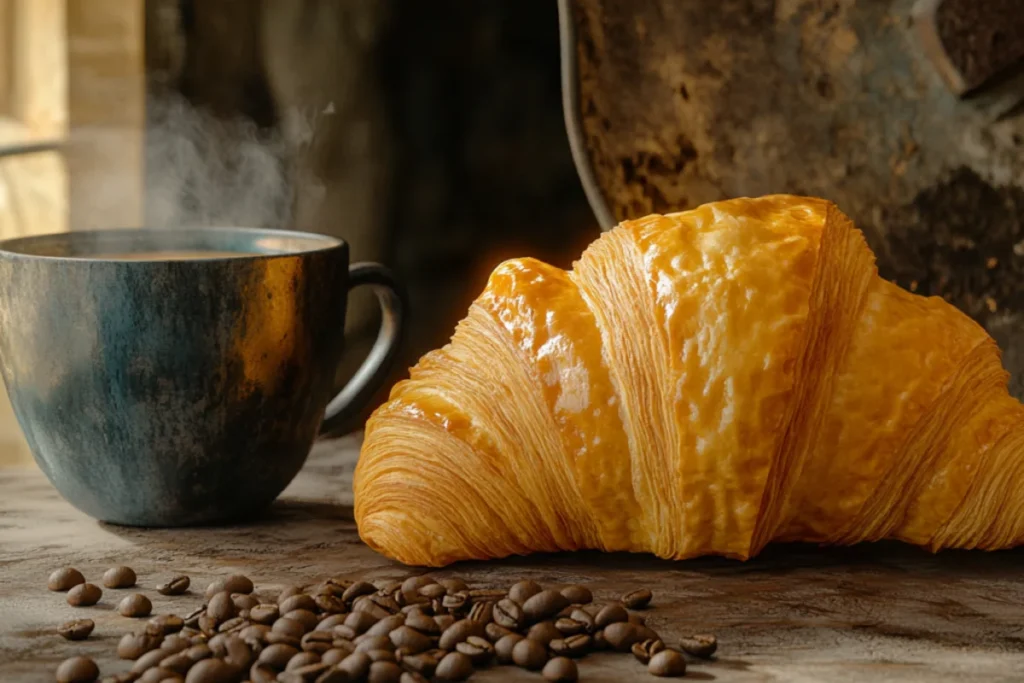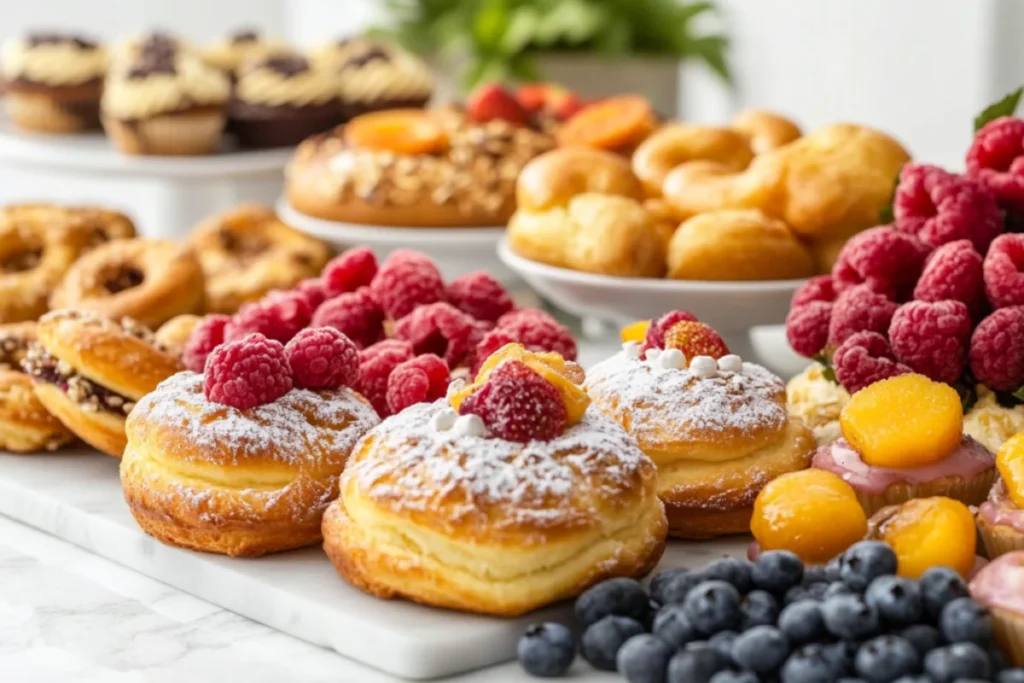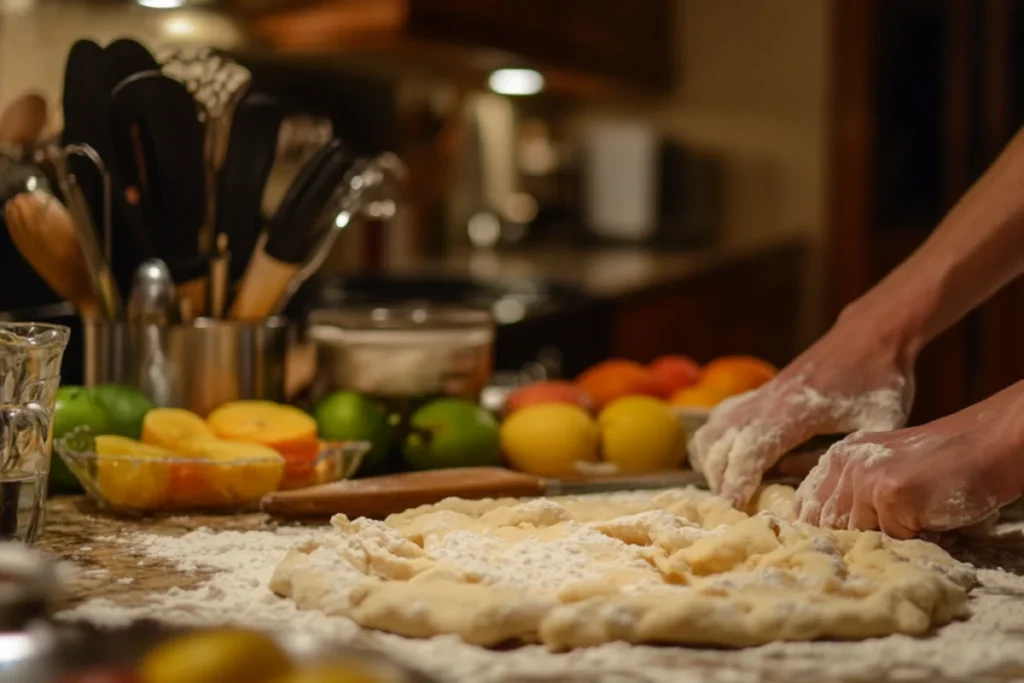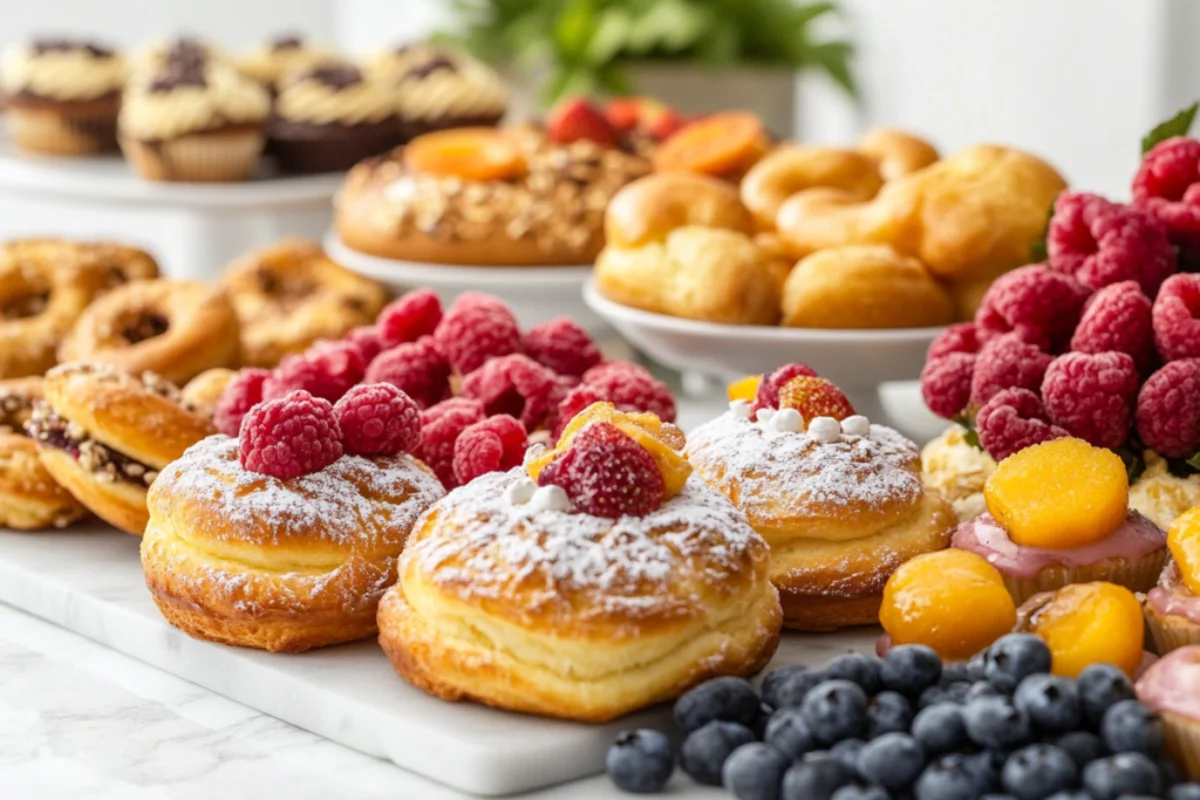
Breakfast Pastries: A Guide to Types, Recipes, and Nutrition
Breakfast pastries are a universally adored morning indulgence, blending comfort, flavor, and convenience into every flaky bite. From the buttery croissants of France to the sugar-glazed donuts of North America, breakfast pastries come in endless varieties, catering to every palate and occasion. Whether you’re savoring a treat with coffee, enjoying a family brunch, or crafting your own at home, these delightful pastries offer more than just taste—they carry history, culture, and creativity in their layers.
In this article, we’ll explore the many faces of breakfast pastries, from classic recipes and international favorites to nutritional insights and DIY options. Ready to dive in? Let’s get started!
Part 1: Introduction and Overview
Breakfast Pastries – A Delightful Start to the Day
Ah, the charm of breakfast pastries! These beloved baked goods are often the centerpiece of a perfect morning. Why are they so irresistible? It’s the combination of rich flavors, light textures, and versatility—they can be sweet, savory, or both! Whether you’re picking up a flaky Danish on your way to work or enjoying a homemade strudel during a weekend breakfast, there’s something magical about starting the day with a pastry.
Globally, breakfast pastries have evolved into a rich tapestry of culinary traditions. Europe brought us laminated doughs, Asia offers bao buns, and Latin America boasts empanadas. Each pastry carries the unique stamp of its origin, yet their universal appeal transcends cultures and generations.
Moreover, breakfast pastries are endlessly adaptable. Modern bakers have embraced healthier variations, such as gluten-free or whole-grain options, ensuring there’s a pastry for every diet and preference. With endless flavors and forms, these pastries prove that breakfast can be both indulgent and nourishing.
History of Pastries is a fascinating topic that reflects the artistry behind these creations. For example, croissants were inspired by Austrian kipferl, a crescent-shaped treat that made its way to France. If you’re curious, dive into the rich history of pastries to learn more.
Now that we’ve whetted your appetite, let’s explore the types of breakfast pastries in the next section!
Part 2: Types of Breakfast Pastries
Popular Types of Breakfast Pastries
When it comes to breakfast pastries, variety is the spice of life. Each type brings its own charm, catering to sweet or savory cravings. Let’s take a closer look at some of the most popular breakfast pastries that grace our tables.
Croissants – The Quintessential French Pastry
The croissant is the epitome of elegance in the world of pastries. Its buttery layers and crescent shape make it a breakfast staple worldwide. Originating from the Austrian kipferl, croissants became iconic in France, where bakers perfected their airy texture through lamination techniques.
Variations like pain au chocolat (chocolate-filled croissant) or almond croissants elevate this classic to new heights. For those attempting croissants at home, using high-quality butter is a game-changer for flakiness.
Danish Pastries – A Sweet European Treat
Danish pastries are synonymous with indulgence. Originally inspired by Viennese bakers, these pastries are known for their soft, layered dough and delectable fillings. Whether topped with cream cheese, fruits like cherries or apples, or custard, Danish pastries are as versatile as they are delicious.
Muffins – A Versatile Pastry for Everyone
Muffins are a crowd-pleaser thanks to their simplicity and adaptability. These single-serve delights can be sweet, like blueberry or chocolate chip, or savory, featuring ingredients like cheese or spinach. Health-conscious bakers often experiment with whole grains and natural sweeteners to create guilt-free versions.
Strudels – Layers of Sweet Goodness
Strudels are a feast for the senses. With origins in Austria, this pastry is known for its thin, flaky layers that wrap around spiced fruit fillings, such as apples or cherries. For a modern twist, strudels can be filled with cream cheese or even savory ingredients like mushrooms and herbs.
Regional Breakfast Pastries Around the World

Breakfast pastries are as diverse as the cultures they represent. Here’s a glimpse at how different regions embrace these morning treats:
North America – Donuts and Sticky Buns
From glazed donuts to caramel-drizzled sticky buns, North America has given the world some of its most indulgent pastries. While donuts are celebrated for their infinite flavor possibilities, sticky buns, with their gooey cinnamon layers, are perfect for sharing during a cozy breakfast.
Asia – Bao and Youtiao
In Asia, pastries lean toward lighter, steamed options. Bao buns, often filled with sweet red bean paste or custard, are a favorite breakfast item. Meanwhile, youtiao, a Chinese fried dough stick, pairs wonderfully with soy milk or congee for a simple yet satisfying start to the day.
Middle East – Baklava and Kunafa
The Middle East offers rich pastries like baklava, layered with nuts and syrup, and kunafa, made from shredded phyllo dough and cheese, drizzled with sweet rosewater syrup. These pastries, while traditionally desserts, are often enjoyed with tea for breakfast.
Latin America – Empanadas and Pastelitos
Latin American pastries strike a balance between sweet and savory. Empanadas, often stuffed with fruits or sweet cream, can be baked or fried. Pastelitos, on the other hand, are known for their flaky crusts and diverse fillings, making them perfect for breakfast or snacks.
In the next section, we’ll dive into the ingredients and techniques that make these breakfast pastries irresistible. Stay tuned!
Part 3: Ingredients and Techniques
Essential Ingredients for Breakfast Pastries
The secret to perfect breakfast pastries lies in the quality of the ingredients. Each element plays a crucial role in determining the flavor, texture, and appearance of these treats.
Flours and Their Role in Texture
Flour is the backbone of any pastry. Different types of flour yield different results:
- All-purpose flour is versatile and ideal for most recipes.
- Pastry flour has lower protein content, resulting in tender, delicate pastries.
- Bread flour provides structure for yeast-based pastries, ensuring a chewy texture.
Understanding the role of gluten in flour helps bakers achieve the desired consistency, whether light and flaky or firm and chewy.
Butter and Its Importance in Flakiness
Butter is a star ingredient in laminated pastries like croissants. Its high fat content creates the signature layers that make pastries both airy and flavorful. Pro tip: Always use cold butter for the best results when laminating dough—it prevents it from melting into the flour prematurely.
For healthier variations, bakers can substitute butter with plant-based spreads, though this may slightly alter the texture.
Sugars and Flavor Enhancers
Sugar doesn’t just sweeten pastries; it also contributes to browning and tenderness. Common alternatives include honey, maple syrup, or even coconut sugar for a caramel-like taste. Don’t forget a pinch of salt—it amplifies the sweetness and balances the flavors.
Baking Techniques for Perfect Breakfast Pastries
Mastering a few essential techniques can transform your pastry game. From achieving flaky layers to balancing flavors, here’s how to perfect your baking process:
Lamination Process for Flaky Pastries
Lamination is the process of folding butter into dough to create layers. It’s essential for croissants and Danish pastries. This technique requires patience but delivers unmatched flakiness. Roll, fold, chill, and repeat—each fold adds more buttery layers to the dough.
Proofing for Yeast-Based Pastries
Proofing allows yeast to ferment, creating air pockets that make pastries light and fluffy. Be sure to proof in a warm, draft-free area, and avoid rushing the process, as under-proofed dough will result in dense pastries.
Filling and Shaping Tips
Filling and shaping are where creativity shines. Whether spreading fruit preserves inside a Danish or folding chocolate into a croissant, even distribution ensures each bite is a delight. Don’t overfill, though—leaks can burn and ruin your presentation.
Baking Temperature and Timing
Baking is all about precision. Use an oven thermometer to ensure accuracy, as incorrect temperatures can alter your pastries’ texture. Typically, laminated pastries bake at higher temperatures (around 375–400°F) to encourage puffing and browning, while muffins or strudels bake at moderate heat (350°F).
For those exploring lamination techniques for pastries, this detailed guide is an excellent resource.
Up next, we’ll examine the nutritional aspects of breakfast pastries and explore healthier options that don’t compromise on taste. Let’s continue!
Part 4: Breakfast Pastries and Nutrition
Are Breakfast Pastries Healthy?
Breakfast pastries, with their rich flavors and buttery textures, might not always be synonymous with health, but they can certainly fit into a balanced diet. The key lies in moderation, mindful pairing, and choosing recipes that cater to your nutritional needs.
Nutritional Value of Common Pastries
Pastries vary widely in their nutritional profiles. Here’s a general idea of what to expect from popular options:
- Croissants: Around 250–300 calories with 12–15g of fat. They’re relatively low in sugar but high in saturated fats due to butter.
- Muffins: These can range from 200 to 400 calories depending on the size and ingredients. Store-bought varieties often contain added sugars and oils.
- Danish Pastries: A single serving can pack 300–400 calories and up to 20g of sugar, thanks to sweet fillings and glazes.
While these numbers might raise eyebrows, balancing these treats with nutrient-rich foods like fruits or yogurt can help offset the calorie load.
Healthier Variations and Substitutes
If you’re looking to enjoy breakfast pastries without guilt, healthier options abound:
- Whole-grain flours: Swap out refined flour for whole wheat or spelt to add fiber and nutrients.
- Natural sweeteners: Use honey, maple syrup, or even mashed bananas instead of white sugar.
- Plant-based alternatives: For vegan-friendly pastries, replace butter with coconut oil and eggs with flax or chia seeds.
These substitutions don’t just improve the nutritional profile but also bring unique flavors and textures to your creations.
Moderation and Pairing Tips
The occasional indulgence in pastries is perfectly fine! To strike a balance:
- Pair pastries with a protein source like eggs or nuts to stay full longer.
- Enjoy them with a serving of fresh fruit for added fiber and vitamins.
- Stick to smaller portions or share a pastry to curb overindulgence.
Why Nutrition Matters for Breakfast Pastries
Understanding the ingredients and preparation methods in breakfast pastries empowers you to make better choices. Whether you’re indulging in a buttery croissant or enjoying a gluten-free muffin, your approach to balance can make all the difference.
Next, let’s explore some DIY recipes for making delicious breakfast pastries at home. With a little effort, you can enjoy fresh, healthier options straight from your oven!
Part 5: DIY Breakfast Pastries

Easy Breakfast Pastry Recipes to Try at Home
Making breakfast pastries at home is an incredibly rewarding experience. Not only do you control the ingredients and flavors, but the aroma of fresh pastries filling your kitchen is truly unmatched. Whether you’re a seasoned baker or just starting, these recipes are easy to follow and adaptable for different tastes.
Simple Croissant Recipe
Croissants may seem intimidating, but with patience and practice, they’re achievable at home. Here’s a step-by-step guide:
- Prepare the dough: Combine flour, yeast, sugar, salt, and milk. Knead until smooth, then let it rest.
- Laminating the dough: Roll out the dough, layer it with butter, fold it, and chill. Repeat this process 3–4 times.
- Shape the croissants: Roll the dough thin, cut triangles, and roll them into crescents.
- Proof and bake: Let the shaped croissants proof until puffy, then bake at 375°F until golden.
For an extra twist, try adding fillings like chocolate sticks or almond paste before rolling.
Quick Puff Pastry Tart
When time is short, a puff pastry tart is a lifesaver. You can use store-bought puff pastry or prepare your own.
- Sweet Version: Spread cream cheese and top with sliced fruits like berries or peaches. Sprinkle sugar and bake.
- Savory Version: Add a layer of ricotta, tomatoes, and herbs, then bake until the edges puff up and turn golden.
This recipe is perfect for breakfast, brunch, or even a mid-day snack!
Homemade Strudel with Apple Filling
Apple strudels are classic and comforting, ideal for a morning treat. Here’s a simplified method:
- Prepare the filling: Cook diced apples with sugar, cinnamon, and a splash of lemon juice.
- Roll the dough: Stretch a sheet of dough thinly over a floured surface.
- Assemble the strudel: Spread the filling evenly, roll the dough into a log, and seal the edges.
- Bake: Brush with melted butter, sprinkle sugar on top, and bake at 350°F until golden brown.
Benefits of Making Pastries at Home
Homemade pastries aren’t just fresher—they’re customizable. You can experiment with healthier flours, control the amount of sugar, or create unique flavor combinations. Plus, there’s a certain joy in sharing freshly baked pastries with loved ones.
Incorporate tips from healthy pastry choices to make your creations more nutritious without compromising on taste.
Next up, we’ll address some frequently asked questions about breakfast pastries. Let’s clear up those lingering doubts!
Part 6: Frequently Asked Questions About Breakfast Pastries
What are the healthiest breakfast pastries?
Healthiest options often include variations made with whole-grain flours, reduced sugar, and natural sweeteners. For instance, whole-wheat muffins with fresh fruit or vegan croissants made with plant-based butter are excellent choices. Pairing these with yogurt or fresh fruit adds nutritional value.
How can I store breakfast pastries for freshness?
Storing pastries properly ensures their flavor and texture remain intact. For most types:
- Room Temperature: Keep them in an airtight container for 1–2 days.
- Refrigeration: Store pastries like Danishes or muffins with dairy-based fillings in the fridge for up to a week.
- Freezing: Wrap individual portions tightly in plastic wrap, then place them in a freezer bag. Reheat in the oven for a freshly baked experience.
Can breakfast pastries be frozen?
Yes! Many pastries freeze well, making them ideal for meal prep. For best results, freeze before baking. When ready to eat, thaw the pastry and bake it fresh. Pre-baked pastries can also be frozen; simply reheat in the oven at a low temperature to revive their texture.
What is the difference between a croissant and a Danish?
Though both are laminated pastries, their key differences lie in the ingredients and shaping. Croissants are savory or minimally sweet, using butter and yeast for flakiness. Danish pastries, on the other hand, are sweeter and often include fillings like custards, fruit, or cream cheese.
Are breakfast pastries vegan-friendly?
Traditional pastries often rely on butter, eggs, and milk, but vegan-friendly versions are widely available or easy to make at home. Substitute butter with coconut oil or vegan margarine, use almond or oat milk instead of dairy milk, and replace eggs with flaxseed or chia seed mixtures.
What’s the best flour for making pastries?
The choice of flour depends on the pastry:
- Pastry Flour: Ideal for delicate, flaky pastries due to its low protein content.
- All-Purpose Flour: Versatile for most recipes.
- Whole-Wheat or Alternative Flours: Great for healthier variations, though adjustments may be needed for texture.
In our next section, we’ll wrap up with a conclusion celebrating the enduring appeal of breakfast pastries. Let’s finish on a sweet note!
Part 7: Why Breakfast Pastries Are Here to Stay
Breakfast pastries hold a special place in the hearts—and bellies—of people worldwide. Their ability to combine comfort, flavor, and versatility ensures they remain a beloved morning tradition, no matter the season or culture. Whether you’re savoring a flaky croissant at a Parisian café, indulging in a sweet Danish at home, or experimenting with healthier homemade recipes, these pastries have a universal charm that transcends borders.
One reason for their enduring appeal is their adaptability. Pastries evolve with the times, embracing new ingredients and techniques while preserving their classic essence. From vegan-friendly recipes to gluten-free options, the world of breakfast pastries continues to grow, offering something for everyone.
Moreover, the act of enjoying a pastry is about more than just food. It’s a moment of joy—a chance to pause, connect, and savor the little things in life. Whether it’s the perfect pairing with your morning coffee or the satisfaction of baking your own creations, pastries bring warmth and happiness to any day.
So, why not take the time to explore this delicious world? Whether as a casual baker or an enthusiastic eater, breakfast pastries invite us all to embrace the art of indulgence. They’re not just a meal; they’re an experience worth celebrating!

